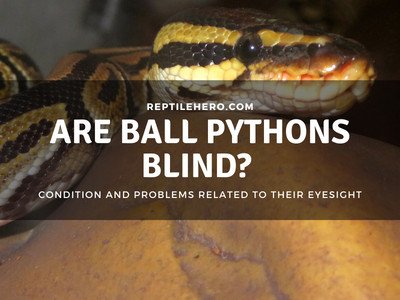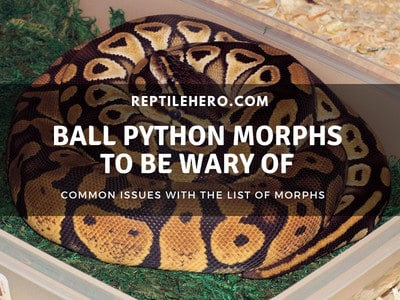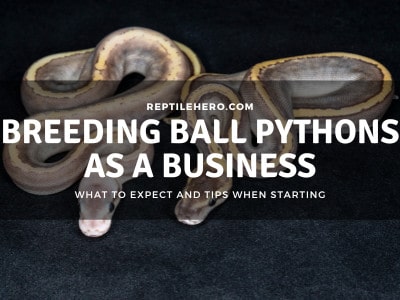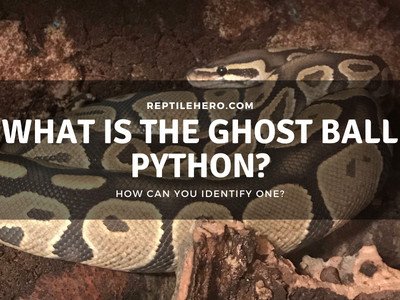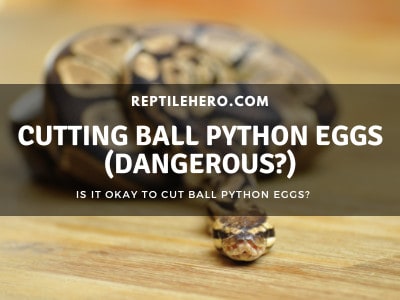Do Ball Pythons Always Hide? (Is It Normal?)
Wondering why your ball python does not come out of its hide? Or maybe you miss having interaction with them. Either way, is it okay to disrupt them while they are hiding?
Ball pythons are crepuscular animals so they will hide most times of the day and only come out during dusk, dawn, and a few hours at night. They may tend to hide more often than normal due to stress, shedding, and a new enclosure.
Is it their natural behavior to hide all the time? When should you be worried and what are the signs to look out for? Learn more as you read below!
Do Ball Pythons Like to Hide?
Ball pythons tend to be more timid compared to bigger snakes in the Pythonidae family, so they hide quite often. On average, ball pythons like to hide especially during the daytime. Then they come out to find prey when it is about to get dark.
A ball python’s shy nature is due to its lack of effective defense, unlike bigger snakes. So to survive in the wild, they will often hide during the day. This behavior is also observed in captivity.

Fun Fact: Ball pythons, in general, are slow and medium-bodied snakes that are known to defend themselves by “balling up.” In doing so, they can tuck in the most vulnerable parts of their body like their neck and head.
3 Reasons Why a Ball Python Hide More Often
Sometimes, ball pythons would not come out of their hides because they might be 1) stressed, 2) shedding, and 3) in a new and unfamiliar enclosure.
1. Stressed
In general, ball pythons that experience stress hide more often. Some factors that might cause stress are light, temperature, humidity, diseases, transit, and handling.
A stressed ball python can also display a lack of appetite and other abnormal behaviors.
1. Light
Ball pythons that are exposed to bright lights will choose to hide most of the time because they are generally crepuscular. This means they are active at dusk/dawn and for a few hours at night.
Especially for transparent vivariums, ball pythons can easily be stressed by bright lights. So I recommend providing opaque hides for your ball python, adding “clutter” like plants and vines to hide under in their tanks, and giving it a lower wattage light source.
2. Temperature
Ball pythons that experience improper temperatures have a high risk of being stressed and, even worse, getting sick. The recommended temperatures are an 85-90°F hotspot and a cold side not lower than 65°F.
More importantly, I recommend using a thermostat for all your heating devices to avoid overheating. Having your light source connected to one can also prolong its life!
3. Humidity
Ball pythons kept in humidity levels that are too low are at risk of getting dehydrated and respiratory issues. This will lead to stress that will cause it to lose appetite and frequently hide.
I suggest keeping the humidity levels at around 50-70% (80% and above when shedding). You can maintain humidity by having less ventilation, misting the enclosure, etc.
>> Learn more about keeping humidity levels properly in our article about foggers and misters for ball pythons
4. Diseases
Sick ball pythons tend to exhibit abnormal behavior which includes refusing to eat and hiding for long periods.
Some common ball python illnesses include scale rot, respiratory infections, and parasitic infestation.
For the diseases mentioned above, I recommend consulting a veterinarian before taking any further actions to ensure the safety of your ball python.
5. Transit
Newly bought ball pythons can often experience stress due to the travel and relocation they have gone through. In addition to this, they can also get stressed from the new environment that they will be put in.
I suggest leaving the newly-acquired ball python undisturbed for at least a week making sure to fill up its water dish only when necessary. Then, try to offer food and once it eats at least twice, it can be handled moderately.
6. Handling
Handling ball pythons are not a requirement in keeping them. It’s mostly done for the keeper’s satisfaction and to tame and make the snake more comfortable with humans.
Keep in mind, however, that handling a ball python improperly can cause stress [1].
I recommend handling a ball python after it has eaten at least 2 meals in your care. I also suggest only handling it for about 5-15 minutes once a day, preferably at night.
2. Shedding
In general, ball pythons that are currently shedding, hide frequently due to feeling vulnerable. They usually shed every 4-7 weeks depending on the rate of their growth.

I discourage handling shedding ball pythons due to the vulnerability and discomfort that they feel at this time. When handled, they may be more defensive and stressed out [2].
Also, I recommend keeping the humidity high around 75-85% when a ball python is about to shed. This will allow them to shed easily and prevent stuck shed.
3. New Enclosure
Most of the time, ball pythons with a newly cleaned enclosure tend to be more reclusive than usual. This is due to the new scents, substrates, and arrangements that will be unfamiliar to them.
You should not worry too much if your ball python acts weird after you put it back in its newly cleaned enclosure. I have experienced the same thing when I deep clean my ball python’s enclosure once a month.
When their enclosure is newly-cleaned, you can see them hide more and sometimes explore around the cage. After one day, if you saw them trying to get out and become restless, it might be due to a strong residue left by cleaning agents like bleach.
I suggest using mild dishwashing liquid, or better yet, a veterinary-grade spray like F10 or a diluted chlorhexidine solution for cleaning. Then, let the enclosure completely dry out.
Make sure that there are no strong smells left inside the tank before placing your ball python back inside.
Ball Pythons Excessively Hiding (and Signs of Illness!)
Most ball pythons love to hide as it makes them feel secure. However, if a ball python hides most of the time and refuses to eat, then there might be a problem. Most of the time this might be caused by improper husbandry and/or illness.
I suggest checking the temperature and humidity if your ball python refuses to eat. The recommended temperature and humidity levels are within 70-90°F and 60-80%, respectively.
To determine whether or not your ball python is sick, I suggest checking its poop, breathing, and movement. I also recommend inspecting its body for external parasites and scale rot [3].

I also recommend checking the area inside your ball python’s hide when spot cleaning. Fecal matter that is close in contact with a ball python’s skin can cause scale rot when left for a prolonged period of time.
3 Methods to Encourage a Ball Python to Come Out of Hiding
Ball pythons can get more comfortable with coming out of their hides by 1) providing them with a proper day cycle, 2) giving them food, and 3) practicing proper handling.
1. Proper Day Cycle
Ball pythons that are exposed to proper day and night cycles tend to be more active around certain times of the day (dawn, dusk, and nighttime). It is recommended to set their lighting fixtures into a timer to emulate this cycle.
I suggest using a low-wattage heat bulb during the day and a lightless heat source during the night to avoid disrupting their day-night cycle.
For the heat bulb, I suggest using a 60-75W halogen light and for nighttime, I recommend using a deep heat projector. Options like heat mat and ceramic heat emitter can also be viable.
I also suggest installing your light and heating devices with a thermostat. I recommend a thermostat like this from amazon. It is easy to use and durable for prolonged usage.
>> Learn more about proper ball python lighting in our article can ball pythons see red light?
2. Offering Food
In general, ball pythons have a high chance of coming out when they are given food. There are 3 general feeding methods for ball pythons which are: live feeding, frozen-thawed, and pre-killed.
1. Live-Feeding
The practice of taking a live feeder, such as rodents, insects, and poultry, and subsequently offering them alive to your omnivorous or carnivorous pet is called live-feeding. This is arguably the best method for feeding picky ball pythons.
Live feeders are likely more nutritious and appetizing than frozen ones, but the act of deliberately sending an animal to its natural predator is understandably unbearable to some keepers.
Moreover, live prey can also cause injuries and parasitic infestations which rarely happen.
2. Frozen-Thawed
Frozen-thawed is the term used for a frozen feeder heated/thawed up for an animal to eat.
On average, more ball python keepers recommend using frozen feeders because they are humane, parasite-free, and easy to store.
Even though a frozen feeder cannot injure your ball python, it can still cause diarrhea when it is eaten after being stored improperly. It is also less nutritious than live ones and less appetizing for some ball pythons.
3. Pre-Killed
Pre-killed feeders are live feeders that are humanely killed before feeding to a carnivore like a ball python. The humane way to euthanize feeders is through carbon gas poisoning and through quick dislocation.
Feeding pre-killed has both the advantages of frozen and live feeders. The only hard part is determining how to humanely kill your feeder. To avoid mistakes, I recommend using a carbon gas chamber.
Pre-killed feeders can also encourage a hiding ball python to come out because it still has traces of body heat and scent, therefore, making it more enticing than frozen-thawed ones.
Euthanizing your feeder through dislocation is an equipment-free and inexpensive method to humanely kill it. Even though it is viable, this method can cause severe pain to the feeder when done incorrectly.
>> Learn more about feeding rodents in our article can you feed mice and rats to a ball python?
3. Correct Handling
Regular handling of ball pythons can make them more comfortable and can encourage them to go out of their hides. It is recommended to handle juvenile ball pythons 3-5 times a week and adults at least once a week.
I recommend handling them for 5-15 minutes at a time while being delicate and careful. It’s also best to use both hands when handling pythons to properly support their bodies when they are on the move.
But, I discourage handling any snake that is in shed and is newly fed to avoid causing stress. Handling newly fed ball pythons may even cause them to regurgitate their food.
>> Learn more about handling shy snakes in our article about ball pythons being head shy.
Choosing the Right Hide for Your Ball Python
It is highly recommended to provide at least 2 hides at different temperature gradients to a ball python [4]. When choosing the right hides, some factors are: 1) size, 2) texture, and 3) security.
1. Size
In total, ball pythons like to hide and feel secure in a tight space. Hides must be tight enough for a ball python to come in contact with its interior. It must be opaque and dark inside as the majority of ball pythons prefer this when hiding.
When you see parts of the ball python’s body poking out underneath the hide, then it is too small for it. Hides with many holes are also not recommended as they allow more light to pass through, thus lessening the feeling of security to a ball python.
Personally, I use a gardening pot in which I sliced one opening on its side to allow my ball python to enter.

It is opaque and dark in color which provides choco, my adult male ball python, a secure place to hide. I also covered some holes using duct tape.
2. Texture
In general, the texture of the hide can be rough or smooth as long as there are no sharp and pointy edges that may end up injuring a ball python.
If you have already bought a hide for your ball python, I suggest making sure that there are no sharp edges. When there are some, you can sand it down using a file, sandpaper, or a hand dremel.
After that, check it again. If a part of the hide still feels sharp to you, then it is a good indicator that it can cause damage to a ball python’s scales as well.
Making a DIY hide? Then make sure to check the edges especially if it is made from plastic. When I made choco’s hide, I sanded down all the edges that he may come in contact with using sandpaper.
On the other hand, if you are looking to buy a good quality hide, I recommend this hide from Amazon. I use this as my humid hide and I found no sharp edges and it looks very nice for my setup.
3. Security
When selecting a hide, it is important to ensure that it is dark inside for the ball python to feel secure. Ideally, it should only have 1-2 holes to allow the ball python to come inside.
I do not recommend clear or translucent hides because a ball python will not feel secure inside it, especially during the day.
I also discourage using long log hides with only 2 holes as it may be hard to coax the ball python out during cleaning and body inspection.
Further Questions
Should I be worried if the ball python does not leave his hide?
When a ball python is hiding most of the time, it is not necessarily as it is in their nature to hide most of the time and to only come out at certain times of the day. But when they refuse to eat after a month then there can be a high chance of disease and/or parasitic infestations.
Why is a ball python hiding under a water bowl?
A ball python will hide anywhere they feel secure. Some ball pythons may feel this while they are under a water bowl. They may also do this if they want a more humid area to hide under. As such, it is recommended to provide a humid hide.
Why is my ball python not coming out of its hide at night?
Even at night, ball pythons may retreat into their hide when they encounter a possible threat. They are also crepuscular meaning they are active during dusk and dawn while being out a few hours at night.
Should I leave ball python alone if he hides all the time?
It is recommended to check the condition of a ball python at least once a week to ensure that they do not have parasites, respiratory disease, injuries, burns, and other complications. Newly-acquired ball pythons tend to hide more and it is suggested to leave them alone for about a week.
Summary of Do Ball Python Always Hide?
On average, ball pythons like to hide especially during the daytime, and come out to find prey during dusk and dawn. Sometimes, ball pythons will stay in their hides because they might be stressed, shedding, and have a new enclosure.
If a ball python hides most of the time and refuses to eat, then there might be a serious problem. Most of the time this might be caused by improper husbandry and/or illness.
Ball pythons can get more comfortable with coming out of their hides if they are provided a proper day cycle, enticing food, and correct handling.
Resources
[1] https://drum.lib.umd.edu/bitstream/handle/1903/20200/1155246.pdf?sequence=1
[2] https://wpvet.com/wp-content/uploads/2021/03/reptile-information-sheet.pdf

